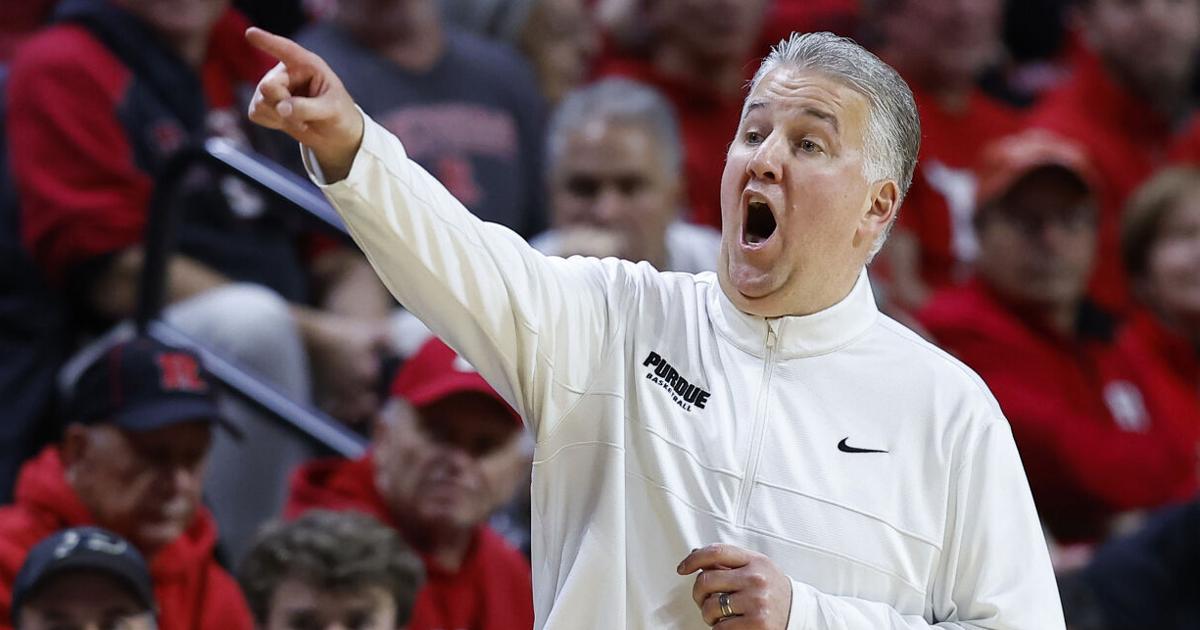Matt Painter does not like adding to his roster in the spring.
He has spoken repeatedly in the past about his preference for filling out his team with high school signees who have locked in their commitments in the fall, so he has some certainty well before a season begins.
This offseason, however, circumstances forced his hand as the Boilermakers lost four players to the transfer portal at the end of the season with only one freshman in its incoming class, leaving a hole in their roster.
So Painter, entering his 21st season leading the Boilers, tried his hand at significant spring acquisitions for the first time. The results show that while he may not prefer it, he is every bit as talented a recruiter in the short-term windows of the transfer portal as he is the years-long courtships of high school recruiting.
“Ultimately, we don’t need to go out and get a different player,” Painter said in March. “We need to keep getting the same guys with the same character and the same makeup we’ve been getting.”
Painter’s work this offseason filled out a roster that was always going to be ticketed for the top of the Big Ten with a pair of All-Americans returning in Braden Smith and Trey Kaufman-Renn. With some high-level newcomers on board, the Boilermakers are on the short list of national title contenders for the coming season, ranked No. 1 in multiple preseason polls.
Here’s a look at the Boilermakers’ roster for the upcoming season.
Additions
Guards: Omer Mayer (freshman), Antoine West (freshman)
Wings: Liam Murphy (transfer, North Florida)
Centers: Oscar Cluff (transfer, South Dakota St.)
Departures
Wings: Myles Colvin (transfer, Wake Forest), Cam Heide (transfer, Texas), Brian Waddell (transfer, Bellarmine)
Centers: Will Berg (transfer, Wichita State), Caleb Furst (out of eligibility)
Projected starters
Guards: Smith, Fletcher Loyer, CJ Cox.
Forward: Kaufman-Renn.
Center: Daniel Jacobsen or Cluff.
Reserves
Guards: Gicarri Harris, Mayer, Murphy, West, Jack Benter.
Forwards: Murphy, Raleigh Burgess
Centers: Jacobsen or Cluff, Burgess.
Greatest strength: Depth
Purdue has just about every skill necessary for success.
Smith, the reigning Bob Cousy Award winner, is almost inarguably the nation’s best playmaker. Meanwhile, Mayer’s sterling work in the Nike Hoop Summit against the top high school players in the US suggests he can be a more-than-capable understudy and Cox can also run the offense effectively if need be.
This being a Painter team, there are shooters all over the roster. Loyer is one of the best in the Big Ten, Murphy was near the top of the Atlantic Sun last season, Cox and Harris could get near 40% from the arc, and youngsters Benter and West have notably smooth strokes.
In the frontcourt, the Boilers have sufficient flexibility to play a variety of different styles. They can maximize rim protection with Jacobsen, rebounding with Cluff or scoring with Kaufman-Renn at center and Murphy next to him in a small lineup.
Add in Harris’ and Cox’s ability to guard on the perimeter and this team has redundancy all over the roster. It should be capable of getting its stars, especially Smith, some rest, keeping them fresh for a deep March run.
Question mark: Athleticism
Purdue is highly skilled across the board and should have plenty of size and toughness, but it is somewhat lacking in elite athletic ability, and it did not help that the two best pure athletes on last season’s team, Colvin and Heide, transferred.
Heide especially was capable of guarding multiple positions and the Boilers likely won’t have quite that level of flexibility defensively on the wing this season.
It remains to be seen what will happen when Purdue faces a high-level wing scorer, such as Michigan’s Yaxel Lendeborg, or a lightning-quick point guard, such as UCLA’s Donovan Dent. Cox showed flashes of being able to guard players of that ilk last season, but he’ll have to take another step to be able to do it consistently, which might be what the Boilers need.
Potential breakout: Jacobsen
The Boilermakers suffered from a lack of rim protection throughout 2024-25, a condition created in large part by the absence of Jacobsen, the 7-foot-4 center who suffered a season-ending leg injury in the first minute of the second game of the season.
Jacobsen is healthy now and has put on more than 30 pounds. He always had the ability to be one of the best shot-blockers in the Big Ten and now it will be far more difficult to move him off the block, giving him outstanding potential as a rebounder.
With Cluff in the fold, it’s unlikely Jacobsen will play 30 minutes per game, but even if he only gets 20, that should be enough for the Chicago native to stamp himself as next in a long line of star Purdue big men.
Outlook
Just minutes after Purdue suffered the gut-wrenching loss to Houston in the Sweet 16 that ended its season in March, Painter made a not-so-bold proclamation:
“I know this: We’ll have a good team next year,” he said.
He also, however, added a prescription for improvement.
“We do need more physicality,” the five-time Big Ten coach of the year said. “That’s what we need. We need to have a more physical team. That’s not their fault, that’s my fault.”
Painter’s solution was to go out and find the nation’s leading rebounder in Cluff from the transfer portal to take some of the weight off Kaufman-Renn. Add in Jacobsen’s rim protection and Purdue’s two biggest problems from last season seem to have been solved.
This is the final year together for the core group of Smith, Kaufman-Renn and Loyer and it is maybe the best chance Purdue has had in the Painter Era to hang a banner in Mackey Arena, with a potentially deeper, more versatile group than the Zach Edey-led team that reached the title game in 2024.
Let the hype start now.

